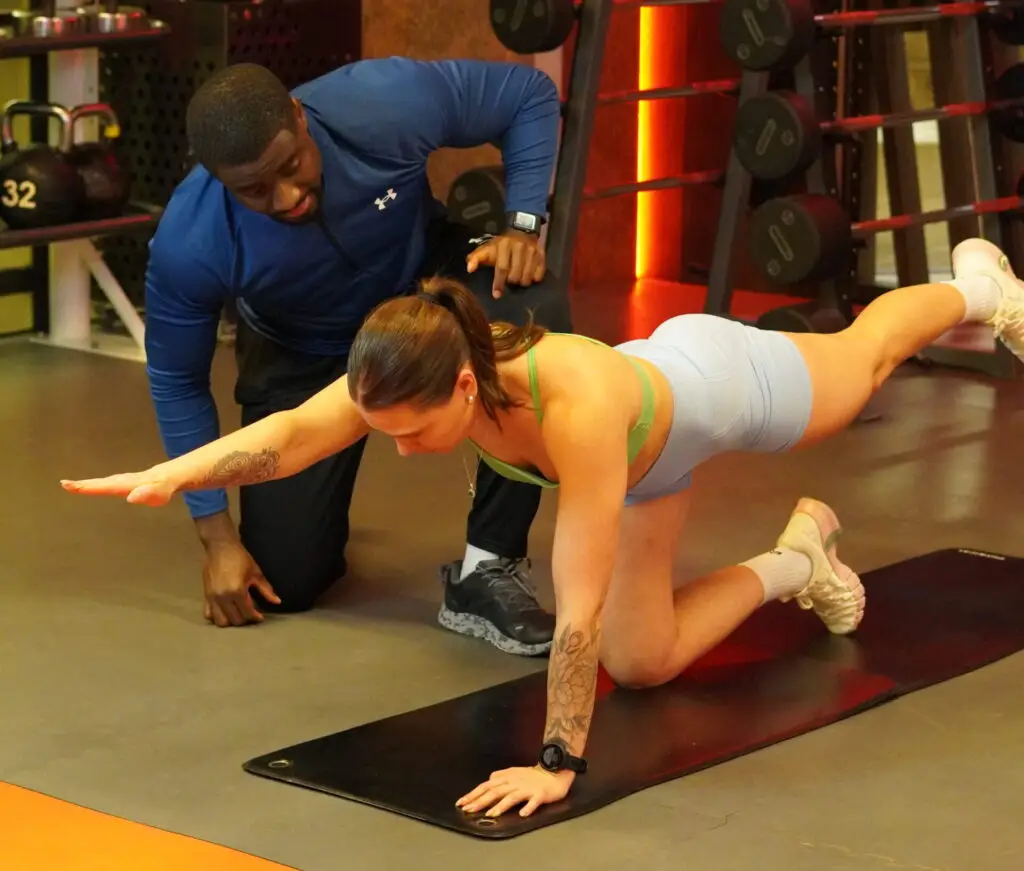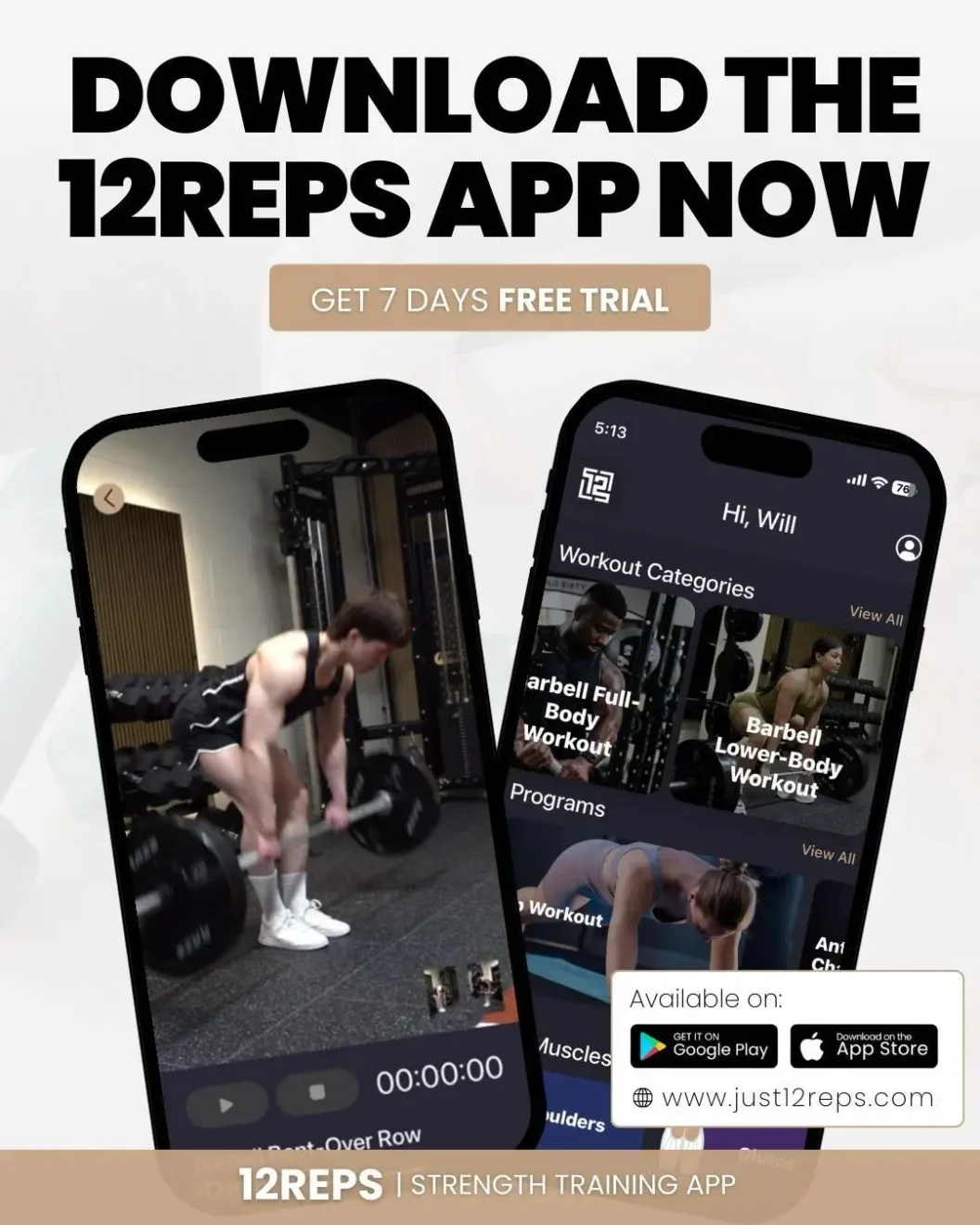Written by Will Duru, BSc (Hons) Sport and Exercise Science, Level 3 Personal Trainer.
People think they need to spend hours in the gym every day to see results. That’s simply not true. The secret isn’t more time; it’s more innovative training. A significant part of that is selecting the right strength training split.
A workout split is just how you divide your training days to work different muscle groups. Pick the right one, and you can get amazing results even if you only have a few hours a week. Pick the wrong one, and you might feel tired, not see progress, or even get injured. My goal with 12Reps was to make smart training easy for everyone, especially those with demanding lives.
In this article, I’ll break down different workout splits that are perfect for busy people. I’ll explain the science behind them, share practical tips, and show you how the 12Reps app can help you plan and stick to a training schedule that fits your life, ensuring you make consistent progress without sacrificing your precious time. Let’s make every minute count!

Why Your Workout Split Matters for a Busy Schedule
When you’re short on time, every workout needs to be effective. This is where your workout split comes in. It’s not just about what exercises you do, but when and how often you do them. A well-chosen split helps you get the most out of your training by:
Frequency means how often you train a muscle group. For muscle growth and strength, hitting each muscle group 2-3 times a week is generally best. A smart split lets you do this without spending all your free time in the gym. For example, a full-body split allows you to train all major muscles in one session, so even if you only train twice a week, you’re still hitting everything twice.
Volume is the total amount of work you do (sets x reps x weight). Recovery is how well your body bounces back after a workout. These two go hand-in-hand. If your split doesn’t allow enough recovery, you risk overtraining, which can lead to fatigue, poor performance, and even injury. A good split balances working your muscles hard with giving them enough time to rest and grow. From my Sport and Exercise Science background, I know that recovery is just as important as the workout itself.
Life happens. Meetings run late, kids get sick, trains are delayed. If your workout plan is too rigid or demands too much time, it’s easy to miss sessions. And consistency is king when it comes to fitness. A flexible, time-efficient split means you’re more likely to stick to your plan, even when things get hectic. It’s better to consistently do a good, shorter workout than to occasionally do a perfect, long one. My clients in the City often tell me that the ability to be consistent is what finally helps them see results.
Now, let’s look at some of the most effective workout splits for busy people. Each has its own benefits, and the best one for you depends on how many days a week you can commit to the gym.
1. Full Body Split (2-3 days/week)
This is often my top recommendation for beginners or those with minimal time. You train all major muscle groups in each session. This means you hit each muscle group more frequently throughout the week, which is excellent for muscle growth and strength, especially when you’re starting out.
Pros: High Frequency: You train each muscle group multiple times a week, which is excellent for building muscle and strength quickly. Time-Efficient: If you can only get to the gym 2-3 times a week, this ensures you work your whole body. Great for Recovery: Since you’re not hammering one muscle group with lots of exercises in a single session, recovery is usually good. Flexible: If you miss a day, it’s not a big deal because you’ll hit those muscles in the next session.
Cons: Can Be Demanding: Each session can feel quite tiring as you’re working your whole body. Limited Volume Per Muscle Group: You might not be able to do as many exercises for each muscle group in one session compared to other splits.
Sample Structure (3 days/week): Monday: Full Body (e.g., Squats, Bench Press, Rows, Overhead Press, Bicep Curls, Tricep Extensions) Wednesday: Full Body (e.g., Deadlifts, Pull-ups, Dips, Lunges, Shoulder Press, Calf Raises) Friday: Full Body (e.g., Leg Press, Incline Press, Cable Rows, Lateral Raises, Plank)
2. Upper/Lower Split (4 days/week)
This split divides your body into upper-body workouts and lower-body workouts. You typically do two upper-body days and two lower-body days per week. This is a fantastic option for those who can commit to four days, as it allows for more focus and volume per muscle group than a full-body split, while still hitting each muscle group twice a week.
Pros: Good Balance: Offers an outstanding balance between training frequency and allowing more volume per muscle group. More Focused Sessions: You can dedicate more exercises and sets to upper or lower body muscles. Effective for Growth: Hitting muscles twice a week with good volume is very effective for building muscle and strength.
Cons: Requires More Days: You need to be able to get to the gym four times a week. Less Flexible: Missing a session can throw off your weekly muscle frequency.
Sample Structure (4 days/week): Monday: Upper Body (e.g., Bench Press, Rows, Overhead Press, Bicep Curls, Tricep Pushdowns) Tuesday: Lower Body (e.g., Squats, Romanian Deadlifts, Leg Press, Hamstring Curls, Calf Raises) Wednesday: Rest Thursday: Upper Body (e.g., Incline Dumbbell Press, Pull-ups, Lateral Raises, Face Pulls, Dips) Friday: Lower Body (e.g., Deadlifts, Lunges, Leg Extensions, Glute Bridges) Saturday/Sunday: Rest
3. Push/Pull/Legs (PPL) Split (3-6 days/week)
This split divides your workouts by movement pattern: Push (chest, shoulders, triceps), Pull (back, biceps), and Legs (quads, hamstrings, glutes, calves). It’s very popular and can be adapted for 3, 4, 5, or 6 days a week. For busy people, a 3-day PPL (hitting each group once a week) or a 6-day PPL (hitting each group twice a week) are common.
Pros: Logical Grouping: Muscles that work together are trained together, which can be very efficient. High Volume Potential: Allows for a lot of exercises and sets for each muscle group in a session. Good for Recovery:Each muscle group gets a whole week to recover if you do a 3-day split, or 3-4 days if you do a 6-day split.
Cons: Less Frequency (for 3-day): Each muscle group is only trained once a week, which might not be optimal for some. Can Be Long Sessions: If you do a lot of exercises, sessions can get quite long. Requires Consistency (for 6-day): A 6-day PPL requires a high level of commitment.
Sample Structure (3 days/week): Monday: Push (e.g., Bench Press, Overhead Press, Dumbbell Flyes, Tricep Pushdowns) Wednesday: Pull (e.g., Deadlifts, Pull-ups, Barbell Rows, Bicep Curls, Face Pulls) * Friday: Legs (e.g., Squats, Leg Press, Hamstring Curls, Leg Extensions, Calf Raises)
Sample Structure (6 days/week): Monday: Push Tuesday: Pull Wednesday: Legs Thursday: Push Friday:Pull Saturday: Legs Sunday: Rest
Choosing the right split depends on your schedule, goals, and recovery rate. The key is to pick one you can stick with consistently.

How 12Reps Customises Your Workout Split to Your Schedule
This is where the 12Reps app truly shines for busy people. I designed 12Reps because I saw how hard it was for my clients to stick to a plan that didn’t fit their crazy schedules. The app takes all the guesswork out of choosing and managing your workout split.
Workouts Built Around Your Life
Instead of you trying to fit your life around a workout plan, 12Reps fits the workout plan around your life. Here’s how it helps you manage your strength training split:
- Tell Us Your Time: When you set up your profile in 12Reps, you tell the app how many days a week you want to train and how much time you have for each session. Do you only have 30 minutes? No problem. Can you train 2, 3, or 4 days a week? The app adjusts.
- Smart Filtering for Your Goals: Based on your input, 12Reps uses its smart filtering system to create a workout plan that matches your chosen split. It knows which exercises work best together and how to make sure you hit all your muscle groups effectively over the week. This means you get a plan that’s not just convenient, but also scientifically sound for building muscle and strength.
- Balanced Muscle Coverage: My Sport and Exercise Science background taught me the importance of balanced training. 12Reps makes sure that even with a busy schedule, you’re not neglecting any muscle groups. It intelligently spreads the work across your chosen days, ensuring proper muscle group coverage and enough recovery time between sessions for each muscle. This helps prevent overtraining and keeps you progressing safely.
- Adapts to Your Progress: As you get stronger, 12Reps helps you with progressive overload (making your workouts harder over time). It tracks your lifts and suggests when to increase weight or reps. This means your split isn’t just a fixed plan; it’s a living, breathing program that grows with you, always pushing you just enough to keep seeing results.
- Easy to Follow: The app provides clear instructions, exercise demonstrations, and a simple logging system. You don’t need to be a fitness expert to understand your split or how to perform the exercises. This ease of use means you’re more likely to stick to your plan and see the benefits of a well-structured split.

Maximising Efficiency Within Your Split
Choosing the right split is the first step. The next step is to ensure that every minute you spend in the gym is as effective as possible. Here are some strategies I teach my clients to maximise their time and results, no matter what split they’re following:
As we’ve discussed in previous articles, compound lifts (like squats, deadlifts, bench press, overhead press, and rows) are your best friends. They work multiple muscle groups at once, giving you more bang for your buck. Prioritise these exercises at the beginning of your workout when you’re freshest. They build the most strength and muscle in the least amount of time.
Supersets involve performing two exercises back-to-back with minimal rest in between. This can be a great way to increase your workout density and save time. For example, you could superset a chest exercise with a back exercise, or a bicep exercise with a tricep exercise. Just be mindful not to compromise form for speed, and avoid supersetting two exercises that heavily tax the same muscle group if you’re aiming for maximum strength on both.
While adequate rest between sets is crucial for recovery and performance, especially for heavy compound lifts, many people spend too much time scrolling on their phones. Keep your rest periods focused. For strength and muscle growth, 60-120 seconds is often ideal. For accessory exercises, you might even shorten them to 30-60 seconds. The 12Reps app can help you time your rest periods effectively.
It’s tempting to lift heavy, but poor form leads to injuries and less effective muscle activation. Always prioritise proper technique. A lighter weight with perfect form will yield better results and keep you in the gym longer than a heavy weight with sloppy form. My Sport and Exercise Science background always brings me back to this fundamental principle: quality over quantity.
Don’t skip your warm-up, but make it effective. A dynamic warm-up (light cardio followed by movement-specific drills) prepares your body without wasting time. Similarly, a quick cool-down with some static stretches can aid recovery. The 12Reps app can guide you through efficient warm-up routines, ensuring you’re ready to perform without unnecessary delays.
Conclusion: Your Path to Consistent Progress, Even When Busy
As a personal trainer who’s seen it all in the City of London, I can confidently say that a busy schedule is no longer an excuse for not reaching your fitness goals. The key isn’t finding more time; it’s about training smarter, and choosing the right strength training split is a massive part of that.
We’ve explored how different splits – from the flexible Full Body to the focused Upper/Lower and the intense PPL – can fit into your life, helping you manage training frequency, volume, and recovery. The science is clear: consistent, well-structured strength training is your ticket to building muscle and getting stronger, no matter how demanding your job is.
And this is where the 12Reps app truly becomes your secret weapon. I built this app because I believe everyone deserves access to smart, effective training that fits their unique life. With its smart filtering and ability to customise workout plans based on your available days and time, 12Reps takes the guesswork out of programming. It ensures you’re always training effectively, making every minute count, and consistently progressing towards your goals
So, if you’re a busy professional ready to stop wishing for results and start achieving them, it’s time to embrace the power of a smart workout split. Let 12Reps be your guide, helping you build a stronger, more resilient you, one efficient workout at a time. Download the 12Reps app today and discover how easy it is to maximise your time and unlock your full potential.








